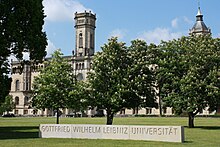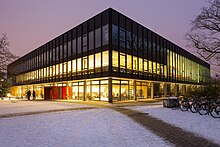|
Leibniz University Hannover
 Leibniz University Hannover (German: Leibniz Universität Hannover), also known as the University of Hannover, is a public research university located in Hanover, Germany. Founded on 2 May 1831 as Higher Vocational School, the university has undergone six periods of renaming, its most recent in 2006.[7][8] Leibniz University Hannover is a member of TU9, an association of the nine leading Institutes of Technology in Germany. It is also a member of the Conference of European Schools for Advanced Engineering Education and Research, a non-profit association of leading engineering universities in Europe. The university sponsors the German National Library of Science and Technology, the largest science and technology library in the world.[9] History The roots of the university begin in the Higher Vocational College/Polytechnic Institute (Höhere Gewerbeschule/Polytechnische Schule), founded on 2 May 1831.[1] In 1879 the Higher Vocational School moved into the historic Guelph palace (Welfenschloss), which was specially converted for the purpose. On 1 April 1879, the Higher Vocational School became the Royal College of Technology (Königliche Technische Hochschule).[2] In 1899 Kaiser Wilhelm II granted the College of Technology a status equal to that of universities and the right to confer doctorates. The college was reconstructed in 1921 with the financial support of the College Patrons' Association. As of 1 July 1922, there were three faculties: Mathematics and Natural Sciences, Civil Engineering, and Mechanical Engineering.[1] In 1968 the Faculty of Humanities and Political Science were founded and the Technische Hochschule ('Technical College' or 'Technical University') became the Technische Universität Hannover ('Technical University Hannover'). Between 1973 and 1980 the faculties of Law, Business and Economics, and the formerly independent Teachers Training College were added to the university and in 1978 the Technische Universität Hannover was renamed Universität Hannover ('University of Hannover'). Student numbers exceeded 30,000 for the first time in 1991. On the 175th anniversary of the institution in 2006, the 'University of Hannover' was given the name Gottfried Wilhelm Leibniz Universität Hannover, or Leibniz Universität Hannover for short. While 64 students first attended the Vocational School, today the university has around 27,200 students, more than 3,400 academics and scientists, and 160 departments and institutes.[10][failed verification] Namesake The Senate of the university voted in April 2006 to rename the University of Hannover to Leibniz Universität Hannover. Following agreement by the Leibniz Academy on the use of the name, the Gottfried Wilhelm Leibniz Universität Hannover received its name on the 360th anniversary of Gottfried Wilhelm Leibniz's birth. The brand of the university is Leibniz Universität Hannover. The old logo of the university was inspired by the Massachusetts Institute of Technology. The current logo, adopted in 2008, is a stylised excerpt from a letter to Duke Rudolf August of Wolfenbüttel, in which Leibniz presented binary numbers for the first time.[11] Faculties and staffNine faculties with more than 190 first-degree full-time and part-time degree courses make the university the second-largest institution of higher education in Lower Saxony. The university staff comprises 3438 research and teaching staff, of whom 357 are professors. It has 1838 additional employees in administrative functions, 58 apprentices and some 1900 staff funded by third parties.[10]
Facilities The campus of the university is spread over 160 buildings occupying 322,700 square metres (79.7 acres) of floor space.[13] BudgetThe university's overall budget was approximately €441.8M in 2013, broken down as follows:[13]
Rankings
As per the QS World 2024, the university is placed 481st globally and holds the 30th position nationally.[14] In the THE World 2024 rankings, the university is placed within the 351–400 range globally, and holds a national rank within the 34–36 range.[15] According to the ARWU World 2022, the university's global position is within the 501–600 range, while nationally it ranks between 32nd and 36th.[16] Measured by the number of top managers in the German economy, Leibniz University Hannover ranked 7th in 2019.[17] Leibniz University Hannover ranked 34th place worldwide in the THE Impact Rankings 2023 – SDG 6 (Clean Water and Sanitation)[18] and between 101–200 in the SDG 7 (Affordable and Clean Energy)[19] rankings. University library and TIB The library was established on the founding of the Höhere Gewerbeschule/Polytechnische Schule in 1831. It expanded into an important collection as the institution evolved from a vocational/technical college into the full University. The removal of the books into storage during the Second World War secured valuable old stocks that became a unique national collection of scientific and technical literature in postwar Germany. This was the basis on which the library of the Institute of Technology (Technische Informationsbibliothek) was established in 1959. Today the collection forms the heart of the German National Library of Science and Technology, which is the largest institution of its kind in the world.[9] GISMA School of BusinessGISMA Business School in Hannover, Germany, was launched in 1999 as a joint initiative by the state of Lower Saxony and visionary private-sector enterprises. The school was closely affiliated with the Krannert School of Management at Purdue University (Indiana, USA) until 2011 when the Leibniz University Hannover briefly became its parent. In 2013 the association with Leibniz ended, and GISMA became part the for-profit education company Global University Systems. Notable peopleFaculty
Alumni
PanoramaSee also
NotesReferences
External linksWikimedia Commons has media related to Universität Hannover. |
|||||||||||||||||||||||||||||||||||||||||||||

